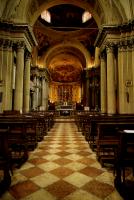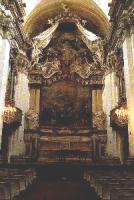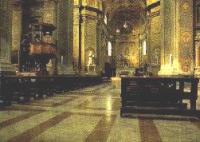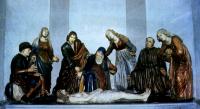|
Modena's XVII Century churches reflect
the important role of the Church in the city's life in the Counter-Reformation
period and share a number of common architectural features. In
the cultural climate after the Council of Trent, church-building
was seen not only as the creation of places of worship, but also
as an opportunity for using architectural splendour to sustain
the Church of Rome against the Protestant threat.
Modena is not a text-book illustration
of this rule, since many of its sacred buildings which date from
this period have interiors richly decorated with mouldings and
paintings, while their extremely simple brick exteriors are almost
concealed in the surrounding urban landscape. (Although anyone
looking upwards can easily appreciate their imposing size, underlined
on the roofs by architectural features such as domes and lanterns).
It is strange to wander through the city centre and note how
these churches are virtually camouflaged between ordinary houses.
In the zone known as the "Terranova" to the North of
the Palazzo Ducale, added to the city by the rebuilding of the
walls in the XVI Century, S. Maria degli Angeli is almost
invisible, between the houses and the cinema Cavour in corso Cavour.
Its status as a church only becomes clear if one looks upwards
above the plastered wall and the discreet wooden doorway to the
large windows and the double tympanum rising above the gutter
lines. Two other XVII Century churches used to be at either
end of the via Emilia, close to the city walls.
 They are S. Agostino,
already described, at the West end and S. Biagio
at the East, the latter with the brickwork of its right-hand side
directly linked to the walls of shops and houses. The only sign
that this church might be a building of some importance is the
small courtyard in front of the door, which leads into an interior
with a single nave, its length emphasised by the depth of the
presbytery. The Baroque profusion of the decorations reaches
the capitals of the columns, but leaves the ceiling bare. The
splendour of the altars in inlaid marble and gilded marquetry
can still be seen, although it has been dulled by time. To the
South of the via Emilia, the facade of the church of S. Carlo
is simply a continuation of that of the College of the same name,
in the usual brickwork and with an unassuming doorway.
They are S. Agostino,
already described, at the West end and S. Biagio
at the East, the latter with the brickwork of its right-hand side
directly linked to the walls of shops and houses. The only sign
that this church might be a building of some importance is the
small courtyard in front of the door, which leads into an interior
with a single nave, its length emphasised by the depth of the
presbytery. The Baroque profusion of the decorations reaches
the capitals of the columns, but leaves the ceiling bare. The
splendour of the altars in inlaid marble and gilded marquetry
can still be seen, although it has been dulled by time. To the
South of the via Emilia, the facade of the church of S. Carlo
is simply a continuation of that of the College of the same name,
in the usual brickwork and with an unassuming doorway.
 However,
an upward glance reveals the massive lantern which contains the
dome, and the elegant lines of the facade, decorated at the sides
by marble vases. Nothing on the outside hints at the magnificence
of the interior, with a "Triumph of Faith" over the
main altar and other Baroque mouldings. The church of S. Maria
delle Assi, a short distance away at the end of Corso Canalgrande,
is partly masked by its connection with the elegant antique pink
of a hotel, and on the other clearly marked as a church by its
small porch raised on four steps. The virtual obliteration of
the lunette fresco, which once portrayed a "Coronation of
the Madonna" and the almost black colour of the ochre exterior
make it obvious that this church is now in disuse. Close to the
now flattened city walls, the church of S. Bartolomeo (via
dei Servi) used to mark the southern boundary of the city and
is connected to the vast edifice which was first a monastery,
and then for a long time the seat of the classical high school.
In the imposing interior with its three wide naves, no effort
has been spared in ensuring that every scrap of wall is covered
by altars, plaster mouldings or paintings. In spite of its size,
the church still obviously looked too small for its builders'
taste, because the perspective paintings on the ceilng extend
its height by creating the illusion of architectural features
and even a dome, with a skilful painting on canvas resting on
the low lantern.
However,
an upward glance reveals the massive lantern which contains the
dome, and the elegant lines of the facade, decorated at the sides
by marble vases. Nothing on the outside hints at the magnificence
of the interior, with a "Triumph of Faith" over the
main altar and other Baroque mouldings. The church of S. Maria
delle Assi, a short distance away at the end of Corso Canalgrande,
is partly masked by its connection with the elegant antique pink
of a hotel, and on the other clearly marked as a church by its
small porch raised on four steps. The virtual obliteration of
the lunette fresco, which once portrayed a "Coronation of
the Madonna" and the almost black colour of the ochre exterior
make it obvious that this church is now in disuse. Close to the
now flattened city walls, the church of S. Bartolomeo (via
dei Servi) used to mark the southern boundary of the city and
is connected to the vast edifice which was first a monastery,
and then for a long time the seat of the classical high school.
In the imposing interior with its three wide naves, no effort
has been spared in ensuring that every scrap of wall is covered
by altars, plaster mouldings or paintings. In spite of its size,
the church still obviously looked too small for its builders'
taste, because the perspective paintings on the ceilng extend
its height by creating the illusion of architectural features
and even a dome, with a skilful painting on canvas resting on
the low lantern.
 The XVII Century churches of S. Domenico
and the Madonna del Voto offer a complete contrast. S. Domenico
is a stone's throw from the Palazzo Ducale, and its massive size
indicates its important role in an area very much created by the
Este family. Its interior, with its Greek cross layout, is very
impressive, but the placing of the altar in the central circle
gives a feeling of intimacy in spite of the vast spaces which
surround it. The huge pairs of columns at the corners of the
cross are pure illusion, created in the scagliola with which the
Carpi masters of the XVII onwards were so skilful in imitating
the costly glories of marble. The Baptistery (to the left of
the main door) contains the terracotta group by A. Begarelli entitled
"Jesus in the Home of Martha and Mary", in which the
realistic modelling of two serving-wenches seems to contrast somewhat
with the Renaissance classicism of the other figures. The church
of the Madonna del Voto, erected by the community in fulfilment
of a vow made to the Blessed Virgin after the ending of the plague
of 1630, stands outside the area of the city dominated by Este
planning, where via Emilia meets Corso Duomo. The building, designed
by the architect known as Galaverna, is less squat than the other
churches of the same period, thanks mainly to its elegant dome,
given an upward thrust by the supporting tambour. Viewed from
Piazza Matteotti, along the perspective offered by its left-hand
side, the church's dome curiously appears to be the same height
as the Ghirlandina tower, and so the white marble decorations
around the dome, with a garland motif, seem to imitate the white
of the Ghirlandina itself. What's more, the metal balustrade
around the base of the turret seems to recall the marble garland
around the pinnacle of the city's main tower.
The XVII Century churches of S. Domenico
and the Madonna del Voto offer a complete contrast. S. Domenico
is a stone's throw from the Palazzo Ducale, and its massive size
indicates its important role in an area very much created by the
Este family. Its interior, with its Greek cross layout, is very
impressive, but the placing of the altar in the central circle
gives a feeling of intimacy in spite of the vast spaces which
surround it. The huge pairs of columns at the corners of the
cross are pure illusion, created in the scagliola with which the
Carpi masters of the XVII onwards were so skilful in imitating
the costly glories of marble. The Baptistery (to the left of
the main door) contains the terracotta group by A. Begarelli entitled
"Jesus in the Home of Martha and Mary", in which the
realistic modelling of two serving-wenches seems to contrast somewhat
with the Renaissance classicism of the other figures. The church
of the Madonna del Voto, erected by the community in fulfilment
of a vow made to the Blessed Virgin after the ending of the plague
of 1630, stands outside the area of the city dominated by Este
planning, where via Emilia meets Corso Duomo. The building, designed
by the architect known as Galaverna, is less squat than the other
churches of the same period, thanks mainly to its elegant dome,
given an upward thrust by the supporting tambour. Viewed from
Piazza Matteotti, along the perspective offered by its left-hand
side, the church's dome curiously appears to be the same height
as the Ghirlandina tower, and so the white marble decorations
around the dome, with a garland motif, seem to imitate the white
of the Ghirlandina itself. What's more, the metal balustrade
around the base of the turret seems to recall the marble garland
around the pinnacle of the city's main tower.
 On the other side,
the square ends with the low brick bulk of the church of S.
Giovanni Battista, its symmetrical ground plan clearly visible
even from the outside. The bell-tower finds a secular counterpart
in the two-floored roof-top loggia on the buildings along via
Emilia, accompanied by a vast array of chimneys. In spite of
its attractive proportions the church is unpretentious, but it
contains a worthy prize for anyone who decides to go inside in
the Deposition by G. Mazzoni, the great XV Century sculptor.
This work in painted terracotta has been undergoing restoration
for some years, but the group of figures in the Madonna della
Pappa on view in the crypt of the Cathedral give a clear ideal
of Mazzoni's realistic style.
On the other side,
the square ends with the low brick bulk of the church of S.
Giovanni Battista, its symmetrical ground plan clearly visible
even from the outside. The bell-tower finds a secular counterpart
in the two-floored roof-top loggia on the buildings along via
Emilia, accompanied by a vast array of chimneys. In spite of
its attractive proportions the church is unpretentious, but it
contains a worthy prize for anyone who decides to go inside in
the Deposition by G. Mazzoni, the great XV Century sculptor.
This work in painted terracotta has been undergoing restoration
for some years, but the group of figures in the Madonna della
Pappa on view in the crypt of the Cathedral give a clear ideal
of Mazzoni's realistic style.
Piazza Matteotti ,
which lies between the two churches of the Madonna del Voto and
S. Giovanni, is an empty modern space hacked out of the city centre
by demolition work in the 1930s. It has now become a square-cum-park,
since its paving of porphyry slabs interspersed with a geometrical
pattern of strips of pink marble is interrupted by tall trees.
They are mainly plane-trees, with a few nettle trees and a handful
of conifers on the edges. Few would regret that for most of the
year the leaves hide the view of the 1950s buildings with a white
arcade in imitation of the Piacenza style, which surround most
of the square. A news-stand and a flower stall in imitation Art
Nouveau style, installed in the late '80s, mark each end of the
square where it borders on via Emilia.
Piazza Mazzini ,
also on the via Emilia just a few metres from Piazza Matteotti,
was created at the beginning of this Century when the old Jewish
ghetto was razed to the ground (the only reminder of its former
presence is the Synagogue which nestles at the far end of the
square). This square also contains a news-stand in Art Nouveau
style, and if we look around it seems an appropriate reflection
of a style found in many of the surrounding buildings. It can
be seen in the lines of a balcony supported by sniggering satyrs,
and on the other side of the square, in multicoloured bands of
painted bas-reliefs. Half of this square is also occupied by
trees, but its turkey-oaks and magnolias create a more exotic,
Mediterranean atmosphere than that of piazza Matteotti.
|
 They are S. Agostino,
already described, at the West end and S. Biagio
at the East, the latter with the brickwork of its right-hand side
directly linked to the walls of shops and houses. The only sign
that this church might be a building of some importance is the
small courtyard in front of the door, which leads into an interior
with a single nave, its length emphasised by the depth of the
presbytery. The Baroque profusion of the decorations reaches
the capitals of the columns, but leaves the ceiling bare. The
splendour of the altars in inlaid marble and gilded marquetry
can still be seen, although it has been dulled by time. To the
South of the via Emilia, the facade of the church of S. Carlo
is simply a continuation of that of the College of the same name,
in the usual brickwork and with an unassuming doorway.
They are S. Agostino,
already described, at the West end and S. Biagio
at the East, the latter with the brickwork of its right-hand side
directly linked to the walls of shops and houses. The only sign
that this church might be a building of some importance is the
small courtyard in front of the door, which leads into an interior
with a single nave, its length emphasised by the depth of the
presbytery. The Baroque profusion of the decorations reaches
the capitals of the columns, but leaves the ceiling bare. The
splendour of the altars in inlaid marble and gilded marquetry
can still be seen, although it has been dulled by time. To the
South of the via Emilia, the facade of the church of S. Carlo
is simply a continuation of that of the College of the same name,
in the usual brickwork and with an unassuming doorway.
 However,
an upward glance reveals the massive lantern which contains the
dome, and the elegant lines of the facade, decorated at the sides
by marble vases. Nothing on the outside hints at the magnificence
of the interior, with a "Triumph of Faith" over the
main altar and other Baroque mouldings. The church of S. Maria
delle Assi, a short distance away at the end of Corso Canalgrande,
is partly masked by its connection with the elegant antique pink
of a hotel, and on the other clearly marked as a church by its
small porch raised on four steps. The virtual obliteration of
the lunette fresco, which once portrayed a "Coronation of
the Madonna" and the almost black colour of the ochre exterior
make it obvious that this church is now in disuse. Close to the
now flattened city walls, the church of S. Bartolomeo (via
dei Servi) used to mark the southern boundary of the city and
is connected to the vast edifice which was first a monastery,
and then for a long time the seat of the classical high school.
In the imposing interior with its three wide naves, no effort
has been spared in ensuring that every scrap of wall is covered
by altars, plaster mouldings or paintings. In spite of its size,
the church still obviously looked too small for its builders'
taste, because the perspective paintings on the ceilng extend
its height by creating the illusion of architectural features
and even a dome, with a skilful painting on canvas resting on
the low lantern.
However,
an upward glance reveals the massive lantern which contains the
dome, and the elegant lines of the facade, decorated at the sides
by marble vases. Nothing on the outside hints at the magnificence
of the interior, with a "Triumph of Faith" over the
main altar and other Baroque mouldings. The church of S. Maria
delle Assi, a short distance away at the end of Corso Canalgrande,
is partly masked by its connection with the elegant antique pink
of a hotel, and on the other clearly marked as a church by its
small porch raised on four steps. The virtual obliteration of
the lunette fresco, which once portrayed a "Coronation of
the Madonna" and the almost black colour of the ochre exterior
make it obvious that this church is now in disuse. Close to the
now flattened city walls, the church of S. Bartolomeo (via
dei Servi) used to mark the southern boundary of the city and
is connected to the vast edifice which was first a monastery,
and then for a long time the seat of the classical high school.
In the imposing interior with its three wide naves, no effort
has been spared in ensuring that every scrap of wall is covered
by altars, plaster mouldings or paintings. In spite of its size,
the church still obviously looked too small for its builders'
taste, because the perspective paintings on the ceilng extend
its height by creating the illusion of architectural features
and even a dome, with a skilful painting on canvas resting on
the low lantern.
 The XVII Century churches of S. Domenico
and the Madonna del Voto offer a complete contrast. S. Domenico
is a stone's throw from the Palazzo Ducale, and its massive size
indicates its important role in an area very much created by the
Este family. Its interior, with its Greek cross layout, is very
impressive, but the placing of the altar in the central circle
gives a feeling of intimacy in spite of the vast spaces which
surround it. The huge pairs of columns at the corners of the
cross are pure illusion, created in the scagliola with which the
Carpi masters of the XVII onwards were so skilful in imitating
the costly glories of marble. The Baptistery (to the left of
the main door) contains the terracotta group by A. Begarelli entitled
"Jesus in the Home of Martha and Mary", in which the
realistic modelling of two serving-wenches seems to contrast somewhat
with the Renaissance classicism of the other figures. The church
of the Madonna del Voto, erected by the community in fulfilment
of a vow made to the Blessed Virgin after the ending of the plague
of 1630, stands outside the area of the city dominated by Este
planning, where via Emilia meets Corso Duomo. The building, designed
by the architect known as Galaverna, is less squat than the other
churches of the same period, thanks mainly to its elegant dome,
given an upward thrust by the supporting tambour. Viewed from
Piazza Matteotti, along the perspective offered by its left-hand
side, the church's dome curiously appears to be the same height
as the Ghirlandina tower, and so the white marble decorations
around the dome, with a garland motif, seem to imitate the white
of the Ghirlandina itself. What's more, the metal balustrade
around the base of the turret seems to recall the marble garland
around the pinnacle of the city's main tower.
The XVII Century churches of S. Domenico
and the Madonna del Voto offer a complete contrast. S. Domenico
is a stone's throw from the Palazzo Ducale, and its massive size
indicates its important role in an area very much created by the
Este family. Its interior, with its Greek cross layout, is very
impressive, but the placing of the altar in the central circle
gives a feeling of intimacy in spite of the vast spaces which
surround it. The huge pairs of columns at the corners of the
cross are pure illusion, created in the scagliola with which the
Carpi masters of the XVII onwards were so skilful in imitating
the costly glories of marble. The Baptistery (to the left of
the main door) contains the terracotta group by A. Begarelli entitled
"Jesus in the Home of Martha and Mary", in which the
realistic modelling of two serving-wenches seems to contrast somewhat
with the Renaissance classicism of the other figures. The church
of the Madonna del Voto, erected by the community in fulfilment
of a vow made to the Blessed Virgin after the ending of the plague
of 1630, stands outside the area of the city dominated by Este
planning, where via Emilia meets Corso Duomo. The building, designed
by the architect known as Galaverna, is less squat than the other
churches of the same period, thanks mainly to its elegant dome,
given an upward thrust by the supporting tambour. Viewed from
Piazza Matteotti, along the perspective offered by its left-hand
side, the church's dome curiously appears to be the same height
as the Ghirlandina tower, and so the white marble decorations
around the dome, with a garland motif, seem to imitate the white
of the Ghirlandina itself. What's more, the metal balustrade
around the base of the turret seems to recall the marble garland
around the pinnacle of the city's main tower.
 On the other side,
the square ends with the low brick bulk of the church of S.
Giovanni Battista, its symmetrical ground plan clearly visible
even from the outside. The bell-tower finds a secular counterpart
in the two-floored roof-top loggia on the buildings along via
Emilia, accompanied by a vast array of chimneys. In spite of
its attractive proportions the church is unpretentious, but it
contains a worthy prize for anyone who decides to go inside in
the Deposition by G. Mazzoni, the great XV Century sculptor.
This work in painted terracotta has been undergoing restoration
for some years, but the group of figures in the Madonna della
Pappa on view in the crypt of the Cathedral give a clear ideal
of Mazzoni's realistic style.
On the other side,
the square ends with the low brick bulk of the church of S.
Giovanni Battista, its symmetrical ground plan clearly visible
even from the outside. The bell-tower finds a secular counterpart
in the two-floored roof-top loggia on the buildings along via
Emilia, accompanied by a vast array of chimneys. In spite of
its attractive proportions the church is unpretentious, but it
contains a worthy prize for anyone who decides to go inside in
the Deposition by G. Mazzoni, the great XV Century sculptor.
This work in painted terracotta has been undergoing restoration
for some years, but the group of figures in the Madonna della
Pappa on view in the crypt of the Cathedral give a clear ideal
of Mazzoni's realistic style.